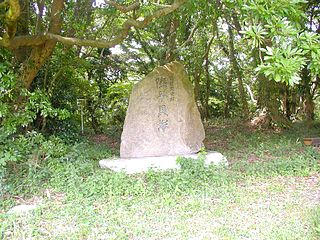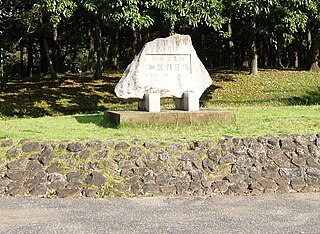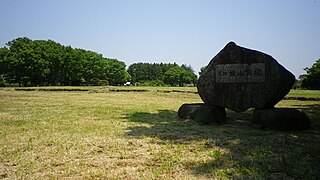Numazu Shell Midden is an archaeological site consisting of a Jōmon period shell midden and the remains of an adjacent settlement located in what is now the city of Ishinomaki, Miyagi Prefecture in the Tōhoku region of northern Japan. It has been protected by the central government as a National Historic Site since 1972.
The Hirohata Shell Midden is an archaeological site in the Iide neighborhood of the city of Inashiki, Ibaraki Prefecture, in the northern Kantō region of Japan containing a late Jōmon period shell midden. The midden was designated a National Historic Site of Japan in 1982.

The Okadaira Shell Midden is an archaeological site in the Iide area of the village of Miho, Ibaraki Prefecture, in the northern Kantō region of Japan containing a late Jōmon period shell midden. The site was designated a National Historic Site of Japan in 1998.

The Ōgushi Shell Midden is an archaeological site in the Shiozaki area of the city of Mito, Ibaraki Prefecture, in the northern Kantō region of Japan containing a Jōmon period shell midden. The site was designated a National Historic Site of Japan in 1970.
The Atamadai Shell Midden is an archaeological site in the Atamadai neighborhood of the city of Katori, Chiba Prefecture, in the Kantō region of Japan containing a Jōmon period shell midden. It was designated a National Historic Site of Japan in 1968.

The Kasori Shell Mounds is an archaeological site in the Sakuragi neighborhood of Wakaba ward of the city of Chiba, Chiba Prefecture, in the Kantō region of Japan. It contains the largest known shell midden found in Japan, and was designated a National Historic Site of Japan in 1971. Its status was raised to that of a special National Historic Site in 2017

The Ubayama Shell Midden is an archaeological site in the Kashiwai neighborhood of the city of Ichikawa, Chiba Prefecture, in the Kantō region of Japan containing a middle to late Jōmon period shell midden. The midden was designated a National Historic Site of Japan in 1967.

The Kotehashi Shell Midden is an archaeological site in the Satsukigaoka neighborhood of Hanamigawa ward of the city of Chiba, Chiba Prefecture, in the Kantō region of Japan containing a Jōmon period shell midden. It was designated a National Historic Site of Japan in 1981.
The Soya Shell Midden is an archaeological site in the Soya neighborhood of the city of Ichikawa, Chiba Prefecture, in the Kantō region of Japan containing a Jōmon period shell midden and settlement ruin. It was designated a National Historic Site of Japan in 1979. The shell mound was formed in the latter half of the Jōmon period, about 4000 to 3000 years ago.
The Tsukinoki Shell Midden is an archaeological site in the Ninomachi neighborhood of Chūō ward of the city of Chiba, Chiba Prefecture, in the Kantō region of Japan containing a Jōmon period shell midden and settlement ruin. The site was designated a National Historic Site of Japan in 1978, with the area under protection extended in 2002 and again in 2006
The Hanawa Shell Midden is an archaeological site in the Kasori neighborhood of Wakaba ward of the city of Ichikawa, Chiba Prefecture, in the Kantō region of Japan containing a Jōmon period shell midden and settlement ruin. The midden was designated a National Historic Site of Japan in 2006.

The Horinouchi Shell Midden is an archaeological site in the Horinouchi neighborhood of the city of Ichikawa, Chiba Prefecture, in the Kantō region of Japan containing a Jōmon period shell midden and settlement ruin. The site was designated a National Historic Site of Japan in 1964, with the area under designation expanded in 1967 and again in 1972.

The Yamazaki Shell Midden is an archaeological site in the Yamazaki-Kaizuka neighborhood of the city of Noda, Chiba Prefecture, in the Kantō region of Japan containing a Jōmon period shell midden and settlement ruin. The site was designated a National Historic Site of Japan in 1976, with the area under designation expanded in 1995.

The Yoshibumi Shell Midden is an archaeological site in the Kaizuka neighborhood of the city of Katori, Chiba Prefecture, in the Kantō region of Japan containing a Jōmon period shell midden and settlement ruin. The site was designated a National Historic Site of Japan in 1930. It was the first shell midden to receive National Historic Site designation in Chiba Prefecture.

The Mizuko Shell Midden is an archaeological site in the Mizuko neighborhood of the city of Fujimi, Saitama Prefecture, in the Kantō region of Japan containing am early Jōmon period shell midden and settlement ruin. The site was designated a National Historic Site of Japan in 1969.

The Shinpukuji shell mound is an archaeological site in the Iwatsuki neighborhood of the city of Saitama, Saitama Prefecture, in the Kantō region of Japan containing a late Jōmon period shell midden and settlement ruin. The site was designated a National Historic Site of Japan in 1975, with the borders extended in 2002 and again in 2016.

The Shinmei Shell Midden is an archaeological site in the Nishioyanoi neighborhood of the city of Kasukabe, Saitama Prefecture, in the Kantō region of Japan containing am early Jōmon period shell midden and settlement ruin. The site was designated a National Historic Site of Japan in 2020.
The Natsushima Shell Midden is an archaeological site in the Natsushima neighborhood of the city of Yokosuka, Kanagawa Prefecture, in the southern Kantō region of Japan containing a Jōmon period shell midden. It was designated a National Historic Site of Japan in 1972. It was then oldest known shell midden in Japan.
The Kōzanji Shell Midden is an archaeological site consisting of a shell midden and the remains of an adjacent Jōmon period settlement located in the Inari-cho neighborhood the city of Tanabe, Wakayama Prefecture in the Kansai region of Japan. The midden was designated a National Historic Site of Japan in 1970.

The Tsukumo Shell Mound is an archaeological site in the Nishioshima neighborhood of the city of Kasaoka, Okayama Prefecture, in the San'yō region of western Japan. It contains a Jōmon period shell midden, and was designated a National Historic Site in 1968.














